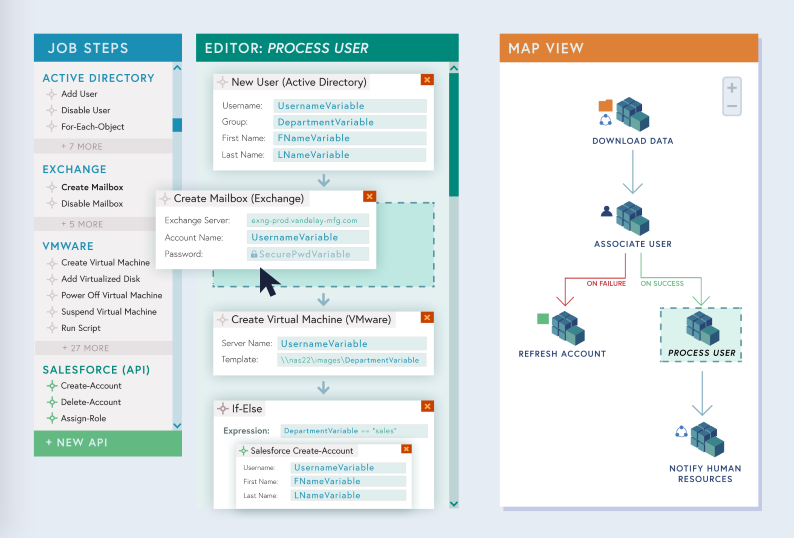What are the Benefits of Low-Code IT Development?
Low-code development is used to design and manage processes, application, and software without having hand-code. Explore the benefits of low-code development.

What is Low-Code Development?
Low-code development is a general term that includes process development solutions, low-code application development, and software development tools.
Low-code development solutions provide building blocks that IT users can assemble into workflows and applications. These building blocks abstract away the code behind actions and commands, making it possible for IT to assemble workflows and business apps without the need for hand-coding.
Why is Low-Code Important?
Over the last 20 years, the variety of tools and technologies available to organizations has skyrocketed. As a result, IT departments are no longer managing homogeneous stacks, but diverse, complex environments. And as those environments have evolved, so too has IT.
Twenty years ago, an IT team could rely on highly specialized employees –the DBA who knew AS/400 inside and out, the director who could list COBOL as a native language, etc. If an ETL process was needed to move data to Cognos, someone could script that.
Today, relying on custom scripts no longer matches the speed and agility that businesses require, while specialization runs counter to the cross-platform processes that are increasingly common. There are precious few developers who have experience in each tool involved in any given end-to-end process.

Low-code development platforms enable IT to quickly assemble new processes and build applications without having to research, write, and test new scripts. Just as important, IT professionals don’t have to have specialized knowledge of every tool or technology involved in a set of processes because the code is abstracted away. With the right low-code tool, just about any IT team member can develop reliable, cross-platform business processes and accelerate application delivery.
Benefits of Low-Code Development
Low-code/no-code development is a term given to a broad range of tools that can be used to develop anything from IT processes to business software. That said, there are a few features that most low-code development platforms have in common, including:
- Direct integrations and low-code API accessibility
- Drag-and-drop workflow designers
- Workflow testing/prototyping facilities
Depending on the platform, a low-code development tool can also include monitoring, resource management, and advanced tools that help streamline devops. But whether you’re looking to deploy an application development platform or a more expansive solution that unifies enterprise processes, low-code development provides a number of benefits to the organization:
- Increased Business Agility
Most low-code platforms are extensible, providing direct integrations with major vendors and enabling IT to turn APIs, web services, and command lines into reusable building blocks. This accelerates the time it takes to integrate and deploy new tools and technologies, helping businesses stay ahead of latest automation trends and consumer demands.
- Reduced CapEx/OpEx
Traditionally, purchasing a new piece of software is faster than developing an in-house solution. Low-code development changes that dynamic. Instead of purchasing a new tool to coordinate SAP jobs, IT can use a low-code platform to quickly assemble the needed processes. Likewise, instead of spending days or weeks researching, writing, and testing new scripts, IT can build those processes in far less time with far fewer resources.
- Less Need for Shadow IT
Business teams have a habit of implementing and managing software without IT’s consent. The reason for this is always the same –IT took too long. By using a low-code development tool to rapidly deploy new processes and applications, IT can drastically reduce the need for shadow IT.
Additionally, intuitive user interfaces can allow business users to execute and monitor processes, while citizen developers/coders can assemble their own applications.
- Automate More in Less Time
Low-code platforms with the right devops tools can accelerate the development speed for automating tasks and end-to-end processes. Workflow automations can be kicked-off based on IT and business events, templates can be used to quickly develop new processes, while variables and flow control make it easier to manage data across platforms. Prebuilt integrations and API accessibility meanwhile make it possible to automate virtually any digital business process.
- Rapid Iterations
Business needs are quickly evolving. To help meet those needs, low-code development platforms can provide tools that help developers to quickly iterate and edit existing processes. For instance, passing changes down to child jobs, requiring documentation, and providing revision histories so that changes can be quickly repealed if necessary. Testing facilities can also be used to ensure processes will run successfully when entered into production.
- Greater Productivity
By streamlining the development process and increasing the use of automation, IT is able to accomplish more in less time. Additionally, low-code applications include tools that simplify the process life cycle. This can include monitoring and alerting capabilities that notify personnel when a process is at risk of failure. Or, if a server is at capacity, to reroute processes to prevent bottlenecks and delays, or execute remediation workflows to maintain SLAs and minimize the time IT spends fighting fires.
Stay ahead of business needs with reliable, reusable integrations
See how API adapters enable developers of any skill level to build connections for end-to-end processes and IT services.
What About Existing Scripts?
The goal of low-code isn’t to replace scripts in entirety –unless that’s what you’re aiming for. Most IT organizations have script libraries that are the product of countless hours of hard work. The scripts are reliable, highly effective, and there’s no real reason to discard them. A low-code platform in this case can be used to secure and improve existing scripts.
Some enterprise solutions designed for low-code process development are script-language independent, enabling IT to build scripts into end-to-end processes without additional coding. Script vaulting is also common, providing a central location from which to store, manage, and secure scripts. Audit trails, revision histories, changesets, and automated documentation can then be used to protect and improve those scripts.
Low-Code vs. No-Code
Low-code and no-code capabilities are often packaged together in the same platform. For example, a low-code process automation solution will provide all the tools and integrations necessary to design processes without having to write custom scripts (no-code). But, that same solution can also provide a scripting environment and enable IT to integrate new or existing code –so that the option for low-code remains.
The real difference between low-code and no-code lies in the platform’s intended user –is the platform meant for non-technical personnel or for those with development skills?
Truly no-code platforms –those solutions that provide only prebuilt actions– are meant for non-IT teams that need limited process or app development (a project management app, or a mobile app for an event, etc.). There is a place for no-code in IT, but explicitly no-code platforms can stifle customization and reduce the number of use cases available for the application.
Is Low-Code the Future?
Probably. Modern computing is, after all, founded in abstraction. Binary is abstracted into languages, languages are abstracted into operating systems and GUIs. Low-code solutions abstract the code that connect those operating systems, databases, and enterprise applications (from BPM to BI, CRM to ERP). Because IT environments are only becoming more complex, the need to abstract those integrations will only grow.
Forrester, for example, expects the low-code development market to reach $21 billion by 2022, up from only $2 billion in 2016.
“By 2024, 75% of large enterprises will be using at least four low-code development tools for both IT application development and citizen development initiatives.”
– Gartner, Low-Code Development Technologies Evaluation Guide
Organizations are quickly adopting new technologies in order to adapt to rapidly changing markets and increased expectations around customer experience. Meanwhile, business leaders are pushing CIOs to develop and lead digital transformation strategies that focus on providing real-time data to customers and end-users.
In order to meet these needs, IT organizations need to be able to quickly develop, orchestrate, and iterate processes and applications, and low-code is how that is being accomplished.
Frequently-Asked Questions
The low-code approach to automation allows users to create workflows with little to no coding. This drag-and-drop functionality makes automation accessible to more people, from junior IT resources to even some business users. This also allows workflows to be created more quickly with little risk of manual errors.
Using a low-code application like ActiveBatch allows organizations to more quickly implement automation. With an intuitive user interface and drag-and-drop functionality, users can use tested job steps, variables and templates to quickly assemble workflows. With no need for custom scripting, users can quickly learn how to use ActiveBatch and start seeing results from their automation initiatives sooner.
It’s important when selecting a low-code application to determine if all the language capabilities the organization needs are supported. IT leaders also need to ensure that the application’s functionality is robust enough to support all the needs of the organization’s workflows.
The low-code approach was created to reduce the need for complex, custom coding and highly-skilled developers. Implementing a low-code application reduces the time to onboard new staff and makes automation more accessible to less experienced developers. It also allows smaller IT teams to accomplish more by leveraging the benefits of low-code automation.
Low-code allows organizations to implement automation quickly, without adding expensive, highly-experienced developers. Low-code allows IT resources to create workflows quickly by using tested job steps, variables, templates and wizards. Workflows are launched faster with less manual work and errors.
Ready to see how we make workload automation easy?
Schedule a demo to see how easy it is to build and maintain your jobs in ActiveBatch.








